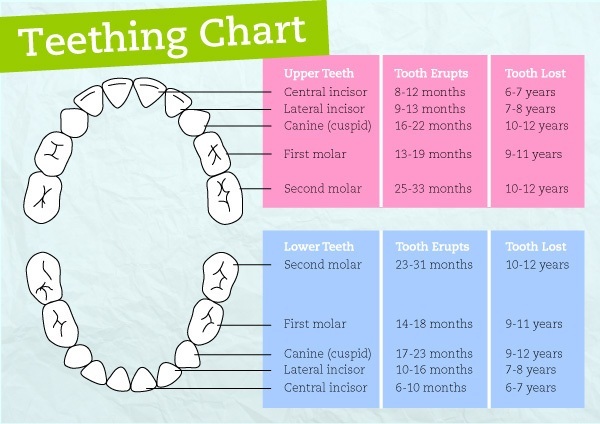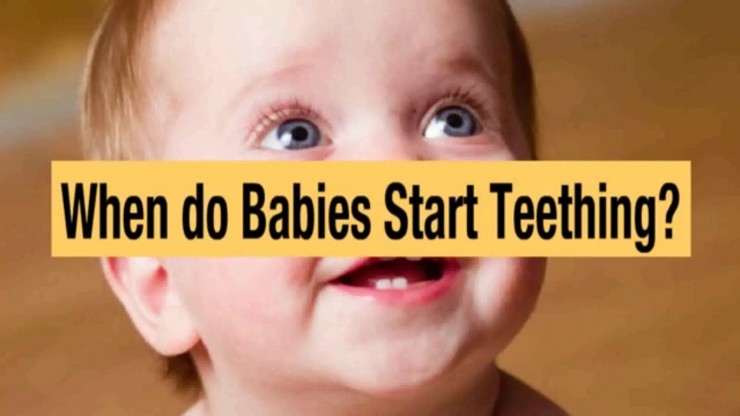The idea of your little one getting their first teeth, it’s kind of exciting to new parents. All new milestones are!
Slowly but surely, this means that solid foods are on the way, and your beautiful baby will start growing up so fast! Parents that have been there before know that teething can oftentimes not be so much exciting, as it can be painful for your little one.
Teething can also be painful for the parents, having to listen to their cries while they deal with these symptoms – there is only so much we can do! Teething just seems to be one of those things that you have to “get through.”
There can be a lot to learn as you are going through these stages – and we’re going to give you as much information and advice here as we can, from parents who have been there.
Let’s start at the beginning and walk through everything that you might want to know, and I will provide you with some tips to make things a little more bearable for all involved.
What, exactly, are we talking about when we say teething?
Teething is when your infant begins to show signs of a tooth breaking through their gums.
It sounds as pleasant as it probably feels.
On rare occasions newborn babies can be born with a tooth or two already erupted. More commonly they are born without teeth and greet you with that big toothless smile.
Or I like to call it, the “gummie smile”.
Table Of Contents
- 1 When Do Babies Start Teething?
- 2 Teething Charts and When Teeth *Usually* Appear
- 3 What to Expect – Signs and Symptoms of Teething
- 4 Drool & Excess Saliva
- 5 Chewing on Everything
- 6 Irritability
- 7 Rash
- 8 Diarrhea
- 9 Diaper Rash
- 10 Fever
- 11 Red Cheeks
- 12
- 13 Sweet Relief…How to Soothe Your Baby Through Teething
- 14 What are some healthy, natural ways to help your baby through a rough teething period?
- 15
- 16 Teething and Breastfeeding
- 17 Brushing Baby Teeth – When Do I Start Brushing My Child’s Teeth?
- 18 Did someone say dentist?
When Do Babies Start Teething?
So, at what age do teeth start coming in? When can I expect my baby’s first tooth and how do we tackle this milestone?
Like everything in life, this will vary child to child – but generally, the average age that children will start to show signs of teething is going to be between 3 months and up to 1 year old.
I know what you’re thinking – that’s a big gap of time! Every single one of our kids are different, so we cannot expect them to develop on the same timeline.
A friend of mine, her son didn’t have any teeth until a few days after his first birthday, when three of them popped up within a week. That was a really difficult week for them! Meanwhile, my son sprouted his first tooth promptly at 5 months old and then didn’t have any more pop up until he was about 10 months.
If you’re curious about your baby’s teething or have questions – go ahead and ask your pediatrician.
They will be able to examine your baby and put any concerns to rest, or to refer you to a pediatric dentist should the need arise. Most likely, everything is fine.
Teething Charts and When Teeth *Usually* Appear
I know you’re likely thinking – “if I have no idea when my child’s teeth will come in, how can I be prepared?!”
Well…there an order to which teeth come in and when (generally) to expect this to happen.
And while your child may not follow these teething charts to a T, it can give you a general idea of when to expect certain teeth to pop up. For me, it was a good indicator – if I noticed my son teething, I would refer to a teething chart and check his mouth to assess which tooth was coming in (mostly so I knew how much trouble we were in)! 😉
For the most part, the first tooth to come through is going to be one of the bottom front teeth. Usually, the second tooth to come in is his little buddy tooth right next to him on the bottom jaw. You might notice that these teeth will start popping up like weeds after this point!
Before you know it there are more and more showing up.
The next couple of teeth to come in are the two front teeth.
From that point on, they will generally start to fill in from the center teeth out.
The molars are the last to come in. These can take up to 33 months before you see them fully come in!
You can find a handful of illustrated guides online to that show the average age, and corresponding tooth that will erupt.
The molars are often the most painful for the little ones, and for obvious reason. They are the biggest.
They can also take a bit longer to fully erupt. I have heard many parents say that these last teeth were the worst for their children. Luckily, they are last so you will have had plenty of experience on how your child handles the sensation, and how you can calm them down.
You can refer to this teething chart below for some more information.

What to Expect – Signs and Symptoms of Teething
What are the signs and symptoms of teething? Some of these symptoms are not believed to be caused by teething, but from personal and anecdotal evidence, I do believe that these issues are strongly linked to when your babe is teething.
Teething can cause some pretty unexpected changes in your child…
Drool & Excess Saliva
If you’re looking for a surefire sign of teething, look where the teething happens – the mouth! When babies start teething, they start drooling…a lot!!
This isn’t the normal amount you see on an everyday basis. You’ll pick up on it quickly, that this isn’t normal and there is something going on in their little mouths – even if you don’t see anything yet – lots of drool = teeth are coming!
Chewing on Everything
They will also start chewing on things.
Anything and everything can be a teething toy for them…toys, furniture, clothes, the pets, their fingers, your face…
Why do babies chew on everything when they are teething? Well, the chewing relieves some of the pressure and soreness that they are feeling. It is natural for them to do this. You may want to invest in some furniture guards once you see this happening, or plan ahead and just put those on the furniture before your little termite starts gnawing away at the crib railing.
Those little teeth do leave quite the mark.
Irritability
Teething can plain put your angel in a bad mood.
For whatever reason, I have noticed that these moods tend to strike most often in the middle of the night.
You might find that you are again having some sleepless nights with your baby, and the cause is teething.
What I noticed with my son, was he would have a sharp cry of pain to indicate something of a toothache – this would turn into crying for about an hour, until the tooth finally broke through. Sometimes it happens gradually, but other times it’s as fast as that. Every baby, and every tooth, will be different.
Rash
Your little one could develop a teething rash around their mouth, because of the drooling.
To prevent this, try to be vigilant about making sure the child’s mouth is wiped off as often as is needed.
Diarrhea
Some other baby teething symptoms can include diarrhea.
Who would have thought?
This is one of those symptoms that you think “why is my baby suffering from diarrhea?” without even thinking to link it to teething.
Diaper Rash
What can diarrhea lead to?
That is right…the dreaded diaper rash.
You can try to prevent these by consistent diaper changing, and use of diaper creams (my favorite is Desitin with Zinc).
However, there might not be much you can do.
If you find that your little ones are battling one of these terribly uncomfortable rashes, you can again use diaper cream, but you can also sprinkle baking soda in their bath.
This will act as a base to their acidic bum.
Fever
The act of teething can cause a child to spike a fever. Along with a fever, your babe might be warm to the touch – not just on their face. My child recently pulled through those dreaded molars, and his whole body was hot to the touch for over 24 hours through the worst of it.
It can be a little daunting because you’re thinking about the pain your little one is in and wanting to do anything to make it better.
You might want to use a fever reducer or pain medication such as ibuprofen – but be careful not to overdo it!
If you think giving some medication is the way to go depending on the situation, please be sure you are paying very close attention to the dosing guidelines, and ask your pediatrician a lot of questions to get their medical advice before administering any medication.
Red Cheeks
Along with a fever and warm body – your little one could have those rosy red cheeks.
This is a no-doubt-indicator that something is going on in their little mouths.
Some kids might not be bothered by teething at all! If this is the case with your child, do not be concerned, but do go right out and buy a lotto ticket. Just kidding! Though, it is not the average experience, it can happen.
Dr. Carol Cooper, in the video below, explains some of the most common signs and symptoms of teething in babies – as well as when you can expect your baby to have their complete first set of teeth!
Sweet Relief…How to Soothe Your Baby Through Teething
What are some of the things that we can do to take away this pain from our children? Because when your little one is letting out those little (or big) cries of pain or suffering through a teething fever – all you want to do is help them.
Before we get into some more natural suggestions on how to relieve teething, I’d be remiss not to give you all the information.
There are some products on the market that can be used to numb the gums.
While there are over-the-counter medications for teething, many of these contain benzocaine – which can have negative side effects. There have been studies that link these topical numbing gels to hardening of the gums, and thus actually causing more damage and pain in the long run.
Don’t get me wrong! I absolutely hate seeing any child in pain. But this can lead to needlessly medicating – which can lead to bigger problems.
Teething is a natural and normal part of early life.
The FDA actually agrees with this sentiment, and advises against these numbing gels. (You can find more info on that here!)
What are some healthy, natural ways to help your baby through a rough teething period?
- A cool washcloth is an old fashioned recommendation. Run some cold water over the washcloth, and let your child chew on it. That cold sensation will help soothe their swollen gums.
- There are also some great ice teething products on the market. Do a quick review of products, or ask a local parenting group, to find one that works best for you. Some kids really latch on to these (pun intended!), and some do not.
- Teething necklaces are also becoming incredible popular over the past 5 years or so. These are necklaces that are designed to be chewed on. Which makes sense, since your child will likely chew on a necklace that is NOT designed for little teeth. It is a great invention to keep in your arsenal.
- Amber teething necklaces are especially trendy, and can even look fashionable. There are some claims that it is even healthy to gnaw on these, and that it can even boost the immune system. I do not know about that and until I see a scientific study I will remain cautiously unimpressed by that claim. That said, it is still a great teething necklace, immunity boosting or no.
The teething child should NOT wear the necklace. It is unsafe for them to have anything of that sort around their neck.
Teething and Breastfeeding
What about nursing?
Am I going to get bitten?
Do I need to stop?
If you’re breastfeeding, yes – there is a chance that you’ll get bitten…and my advice if this happens is to try not to scream or react in any interesting way.
Make sure you let the child know not to do that, but if you create a big fuss your little one is going to want to do it again just to see what happens next. Babies are curious creatures like this and an interesting reaction (even if it’s negative) is curious to them.
So, be boring about it (no matter how much you want to curse at the feeling of a baby teething your nipple) – but insist that it is not okay for them to chew on you while you are nursing. They will likely do it once or twice, but loose interest and go back to just plain old eating.
If your child is old enough to understand, maybe say something like “that gives mommy an ouchie” or “don’t hurt mommy – ow!”
Brushing Baby Teeth – When Do I Start Brushing My Child’s Teeth?
Yes, you will want to begin brushing your child’s teeth after your little one sprouts their first few teeth – it’s important to keep them healthy and clean!
You can even start this process before teeth emerge! I always recommend wiping, or using a gum brush on your child’s teeth to keep the gums clean.
If you do this, not only will your child have nice clean gums but they will be used to the basic motions of teeth cleaning. Once teeth start to come into the picture, oral hygiene is going to be really important.
If you want more suggestions on baby teeth cleaning, check out the quick little video below from Children’s Health Chats on caring for your baby’s teeth!
There are special toothpastes on the market for children that are very young.
We are talking under 3 or 4 years old.
Basically, these tooth pastes have no fluoride in them since we do not want our kids swallowing that. Very young kids do not quite grasp the concept of spitting out the toothpaste, so it is important to stick with the toddler brands.
Even once they do get the hang of spitting out the toothpaste, consult with your pediatric dentist before using fully fluorinated toothpaste.
Did someone say dentist?
It is a fantastic idea to take your child to the dentist once they are around 1 year old. This will get them familiar with the procedure, and they will be more comfortable with it. The checkup is usually very casual, and not particularly involved. The dentist will likely do a brief exam.
Rarely is a cleaning needed until your child gets a little bit older. You can take your child to a pediatric dentist, but you do not have to. The pediatric dentist will be used to dealing with young children, and may have a more kid friendly atmosphere.
That said, if you have a dentist you really enjoy and feel comfortable with, go ahead and introduce your baby to that dentist!
In short, when do babies start teething? We can never tell you exactly when and what to expect when it comes to babies – and teething is no different. But hopefully with this information, you can know the signs and have some idea on how to soothe your babe through this tough time!


Leave a Reply